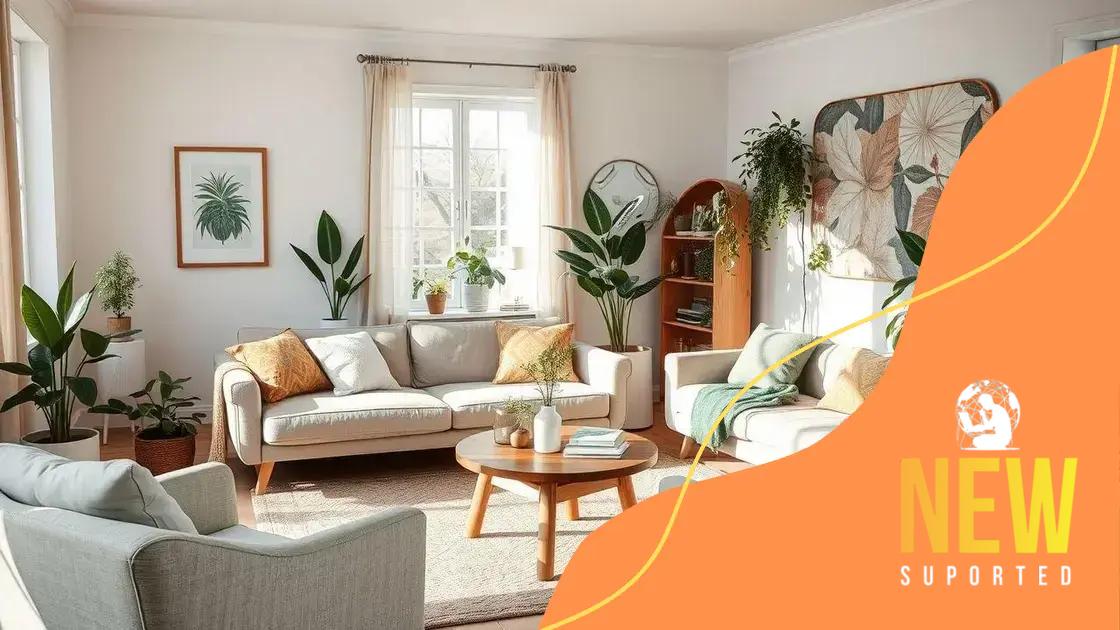How to incorporate sustainable design in home decor

To incorporate sustainable design in home decor, use eco-friendly materials, add indoor plants, upcycle furniture, and optimize energy efficiency for a healthier living environment.
How to incorporate sustainable design in home decor is more than just a trend—it’s a commitment to a healthier planet. Have you ever thought about how your choices can make a difference? Dive into practical ideas that not only beautify your home but also support sustainability.
Understanding sustainable design principles
Understanding sustainable design principles is essential for creating spaces that are not only beautiful but also environmentally friendly. At its core, sustainable design seeks to minimize negative impacts on the environment while enhancing the quality of life for homeowners.
Key Components of Sustainable Design
Several key components define sustainable design. These elements ensure that homes are both aesthetically pleasing and kind to the planet. The main principles include:
- Energy efficiency: Utilizing energy-efficient appliances and designing for natural light can significantly reduce energy consumption.
- Water conservation: Implementing water-saving fixtures and rainwater harvesting systems can decrease water usage in homes.
- Material selection: Choosing sustainable, renewable, or recycled materials lessens environmental impact.
- Indoor air quality: Using non-toxic materials and ensuring proper ventilation promotes healthier living spaces.
Additionally, it’s important to consider how buildings interact with their surroundings. Utilizing local materials reduces transportation emissions, while designing for the local climate can enhance comfort and efficiency. More than just the materials used, sustainable design also emphasizes creating a sense of place, connecting people with their environment.
Implementing Sustainable Practices
Implementing sustainable practices is where theory meets action. Homeowners can start small, perhaps by incorporating plants into their decor to improve air quality and bring nature indoors. Another practical step is to choose furnishings made from reclaimed wood or recycled materials. Alongside furniture choices, integrating natural lighting through strategically placed windows can reduce reliance on artificial light.
Thinking about the home’s energy source is also vital. As more homeowners switch to renewable energy sources like solar panels, the demand for fossil fuels decreases, benefitting the environment in the long run. Overall, adopting sustainable design principles is about making conscious choices that contribute to a healthier planet while enhancing personal living spaces.
Choosing eco-friendly materials
Choosing eco-friendly materials is a vital aspect of sustainable design. These materials not only reduce environmental impact but also create healthier living spaces. By selecting the right products, you contribute to a more sustainable future while enhancing the beauty of your home.
Types of Eco-Friendly Materials
There are various types of eco-friendly materials that you can use in your home decor. These choices are not only safe for the planet but also stylish:
- Recycled materials: Items made from recycled wood, glass, or metals can add unique character and minimize waste.
- Bamboo: This renewable resource is highly sustainable and works well for flooring, furniture, and decor.
- Natural fibers: Materials such as cotton, wool, and jute are biodegradable and have a lower environmental impact than synthetic options.
- Low-VOC paints: Volatile organic compounds (VOCs) can harm indoor air quality. Low-VOC paints offer vibrant colors without the harmful effects.
Incorporating these eco-friendly options in your design not only makes a statement but also promotes a healthier living environment. For example, opting for reclaimed wood furniture adds warmth and personality to your space. Similarly, using carpets made from natural fibers can enhance comfort while keeping the indoor air quality safe.
Benefits of Eco-Friendly Materials
Choosing eco-friendly materials brings numerous advantages. Firstly, it decreases the demand for new resources, promoting conservation. Additionally, using natural products can enhance aesthetic appeal and create a tranquil atmosphere in your home. Furthermore, these materials tend to be more durable, which reduces the need for frequent replacements. With the right choices, you will feel good about your decor while contributing positively to the environment.
When it comes to sustainable design, the materials you choose play a critical role in minimizing your ecological footprint. By prioritizing eco-friendly options, you are not only making a responsible decision but also fostering a healthy and beautiful living space.
Incorporating plants into your decor

Incorporating plants into your decor not only beautifies your space but also promotes a healthier environment. Plants can enhance air quality and provide a calming influence, making them an essential element in sustainable home design.
Benefits of Having Plants Indoors
Adding plants to your home decor has many benefits that go beyond aesthetics. For starters, they can:
- Improve air quality: Plants absorb carbon dioxide and release oxygen, creating fresher air.
- Reduce stress: Studies have shown that being around nature can alleviate stress and improve mood.
- Enhance creativity: Greenery can boost creativity and productivity, making it perfect for home offices.
- Add color and texture: Plants bring life to a room, adding vibrant colors and interesting textures.
With these advantages, it’s clear that incorporating plants into your home decor is a smart choice. You don’t need a green thumb to enjoy plants; many low-maintenance options, like succulents and peace lilies, are perfect for beginners.
Ways to Incorporate Plants in Home Decor
There are numerous ways to creatively display plants in your home. You can start by placing small pots on shelves or windowsills. Larger plants, like fiddle-leaf figs, can serve as stunning floor accents. Consider hanging planters to save space and create visual interest.
Another idea is to create a dedicated plant corner. This small area can be filled with various plant species, offering a mini indoor garden experience. Don’t forget to choose pots that complement your interior style! You can find pots in various materials, colors, and sizes that fit your decor theme.
Using plants as part of your table settings, such as a small succulent as a centerpiece, can add a special touch to dining experiences. These elements tie together natural beauty and functionality, making your home more inviting.
Upcycling and repurposing furniture
Upcycling and repurposing furniture offer fantastic opportunities to give new life to old items while contributing to sustainable design. These practices not only save money but also reduce waste and add a unique touch to your home.
Benefits of Upcycling Furniture
There are several benefits to upcycling furniture. By transforming old pieces, you can:
- Save resources: Upcycling reduces the need for new materials, which helps decrease environmental impact.
- Express individuality: Customized pieces reflect your personal style and make your home unique.
- Save money: Instead of buying new furniture, upcycling can be a cost-effective solution.
- Enhance creativity: The process encourages innovative thinking and creative problem-solving.
When you upcycle, you have the freedom to turn an old dresser into a stylish bathroom vanity or transform a wooden pallet into a chic coffee table. These creative projects can be fun and rewarding, making your space stand out.
Ideas for Repurposing Furniture
Repurposing furniture is all about seeing potential in items that may seem outdated or worn out. For example, an old ladder can become a unique bookshelf, or a vintage trunk can serve as a coffee table with extra storage. Consider these ideas:
- Old doors: Use them as headboards or tabletops.
- Chairs: A mismatched set can be painted in coordinating colors to create a cohesive look.
- Suitcases: Stack them for an eye-catching side table or hang them on walls for creative storage.
Embracing upcycling not only fosters creativity but also promotes a sustainable lifestyle. It allows people to connect with their furniture’s history while making it functional for modern living. By choosing to upcycle, you contribute positively to the environment and showcase your ingenuity.
Creating energy-efficient spaces
Creating energy-efficient spaces is an essential component of sustainable design. It not only helps to reduce your carbon footprint but also leads to long-term savings on energy bills. By optimizing your home for energy efficiency, you can create a more comfortable and eco-friendly living environment.
Key Strategies for Energy Efficiency
There are several strategies you can implement to enhance energy efficiency in your home. These methods focus on reducing energy consumption while maintaining comfort:
- Install energy-efficient appliances: Look for appliances with the ENERGY STAR label, as they consume less energy than standard models.
- Use smart thermostats: These devices can learn your schedule and adjust heating and cooling automatically, helping to save energy.
- Improve insulation: Proper insulation prevents heat loss during winter and keeps your home cool in summer, reducing the need for heating and air conditioning.
- Seal windows and doors: Installing weather stripping and caulking can eliminate drafts and maintain indoor temperatures.
In addition to these strategies, consider using renewable energy sources, such as solar panels. These systems harness energy from the sun, reducing dependence on grid electricity and lowering overall energy costs.
Designing for Natural Light
Designing your space to maximize natural light is another effective way to create an energy-efficient environment. Large windows, skylights, and open floor plans can reduce the need for artificial lighting during the day. Utilizing light colors for walls and furnishings can reflect natural light and brighten rooms without excessive energy use. Layering window treatments can control light levels while maintaining privacy.
Creating energy-efficient spaces is not only about saving money but also about contributing to a sustainable future. Small adjustments in design and daily habits can lead to significant energy savings. By focusing on energy efficiency, you can enhance your home’s comfort and protect the environment.
Creating a sustainable and energy-efficient home is a rewarding journey. By incorporating plants, using eco-friendly materials, upcycling furniture, and optimizing energy use, you contribute to a healthier environment. Remember that every small change counts. Whether you choose to repurpose old items or select renewable energy sources, your efforts can make a significant impact. Together, we can create beautiful spaces that benefit both us and the planet.
FAQ – Frequently Asked Questions about Sustainable Home Design
What are the benefits of incorporating plants into my home decor?
Incorporating plants improves air quality, reduces stress, and enhances the beauty of your space, making it more inviting.
How can I upcycle my old furniture?
You can upcycle by repainting, reupholstering, or creatively repurposing old furniture into new functional items like tables or storage solutions.
What are some energy-efficient upgrades I can make in my home?
Consider installing energy-efficient appliances, using smart thermostats, improving insulation, and sealing any drafts around windows and doors.
Why is using eco-friendly materials important?
Eco-friendly materials reduce environmental impact, promote sustainability, and often improve indoor air quality, contributing to a healthier home.






